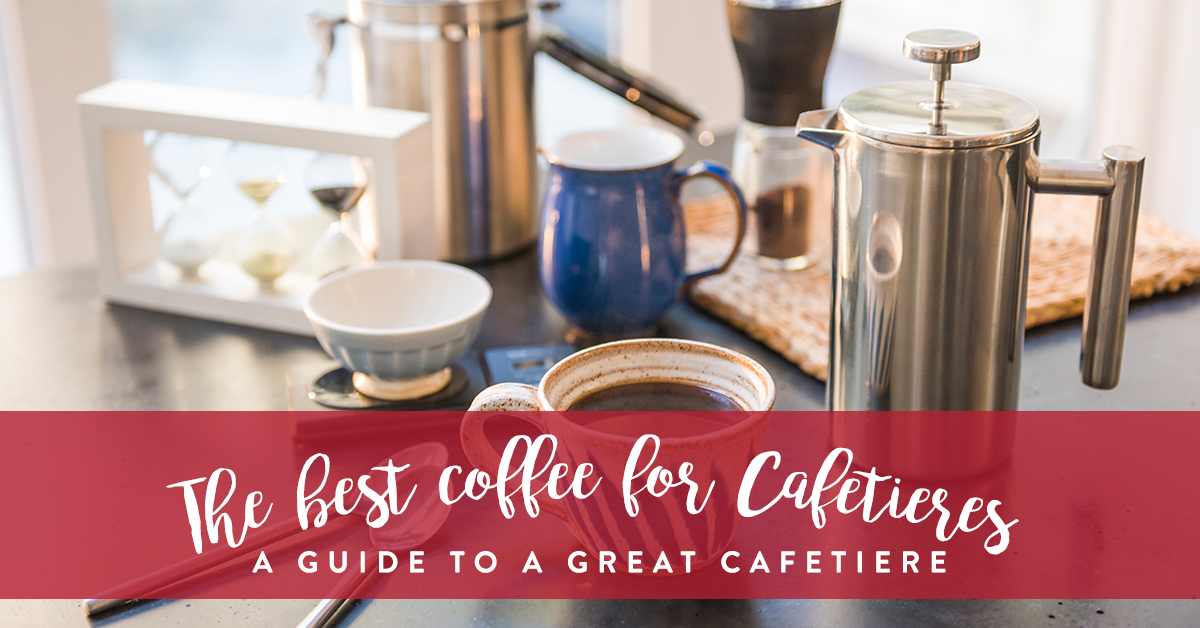
The Best Coffee For Cafetières
Despite the increasing take-up of domestic bean-to-cup and capsule coffee machines, plus the wide range of cool coffee brewing devices available for those making coffee at home, the humble Cafetière is still the most popular way of making fresh coffee at home in the UK. The Cafetière is popular because of its ease of use. For simplicity, there's no better method of making coffee than the Cafetière, or French Press, and it is also favoured for the clear and true taste it creates.
But, choosing the right coffee for your Cafetière can seem like a daunting challenge because there are several factors to consider, including: bean provenance, roast level and grind type. The good news is that the cafetière is a versatile and forgiving brewing method, which means you can experiment with these factors to find the flavours and coffees you will enjoy.
How to Choose Coffee for Your Cafetière
When it comes to brewing coffee in a Cafetière, in our opinion you can more or less brew whatever you like! However, the Cafetière does have some characteristics which are worth considering as you make your choice.
This brewing method is actually very effective at drawing out the full flavour of a coffee. The reason relates to the relatively long period of time (several minutes) that the coffee is left in contact with the water to extract flavour, combined with the impact of force on the coffee when the press is pushed down on the grounds. As a consequence, some people may avoid using strong and intensely flavoured coffee, or bitter coffee, in Cafetières since this method is likely to accentuate the flavour to the extent that it can be over powering. On the other hand, those who like very strong tasting coffee will often use a Cafetière specifically for that purpose.
While your choice of coffee really does come down to personal preference, there are three main variables to consider when looking for coffees to try in your Cafetière:
ProvenanceWe encourage our customers to try both coffee bean blends and single origin coffees in their French Press, since they give different qualities. Blends tend to offer a rich and full-bodied flavour year-round, while the subtle fruits, nuts and acidity of single origin coffees are often easier to detect when brewed in a Cafetière.
African coffees are usually fruity and bright. They are a great choice for lovers of fragrant coffee and the Cafetière normally draws out these subtle flavours very well. However, if you prefer to take milk in your coffee, fragrant African coffees are not considered to mix well with milk.
Another option is to try South American coffees, which tend to be darker, nuttier and more chocolatey. These coffees work well with the Cafetière. For example, our Spiller & Tait Signature Blend includes a high percentage of beans from Columbia and Brazil. This coffee is regarded by many of our customers as one of the best coffees for French Press available in the UK.
Indonesian coffees are a great option with the French Press. For example, many Sumatran coffees are rich and full-bodied, giving a robust taste that you will not find with many other coffees. While they typically have deep tones, they are also gentle, making them easy to enjoy cup after cup.
Recommended roast level for CafetièresDark roast coffee tends to taste quite strong. Therefore, brewing in the French Press will provide a stronger, more bitter taste to your brew. If you like your coffee with a little bit of kick and punch to it, this will probably be your ideal Cafetière coffee. If, on the other hand, you’re not used to a strong, bitter tasting coffee, it can be over powering.
Medium and lighter roasts tend to have more of an ‘earthy’ taste. They carry more of the natural bean aroma and a more intense flavour of the fresh coffee bean and when brewed in a Cafetière those more subtle flavours can be more easily detected than, say, a coffee brewed in an Espresso or Filter Drip method.
Recommended grind level for CafetièresIn our experience, grind level is one of the most important factors contributing to the flavour of your Cafetière coffee. A good batch of French Press coffee requires a coarse, even ground often known as a Cafetière grind. This means that if you are buying pre-ground coffee, you want to avoid anything that's ground for espresso, whose grind is too fine for French Press.
A Cafetière is a relatively slow brewing method. As the water is in contact with the ground coffee for several minutes, you want to use a coarse grind to avoid over-extraction. Over-extraction makes the coffee taste acidic and bitter.
But, your best bet for great French Press coffee is of course to grind it yourself just before you brew. If you buy beans and grind the coffee as you go, you’ll have a fresher and better tasting finished brew since the aromatic oils in the coffee, which are the source of its flavour, dissipate and escape over time after the beans have been ground.
If you’re buying pre-ground Spiller & Tait coffee, our “Omni grind” is set to a level of coarseness which is ideal for French Press coffee.
Having chosen a coffee to try in your Cafetière, you’ve now got a whole range of other decisions to make. These include: what’s the ideal French Press coffee-to-water ratio; how much coffee do you use for 1 cup; how much coffee do you use for 2 cups; and which Cafetière is actually the best to use?
As with your choice of coffee, the answers to these questions do eventually come down to personal taste preference, but, for more guidance on how to get the best from your Cafetière, consult our Cafetière Brew Guide and watch the short video below.


